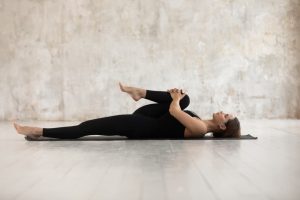
A herniated disc is a common back injury that occurs when a disc’s inner layer pushes out through its rubbery exterior. The resulting back pain, neck pain, limb pain, tingling, and weakness may discourage you from exercising. Overexertion can indeed add stress and make your back feel worse.
However, some forms of exercise are gentle on your back and can even ease the nerve compression causing your pain. Once your medical team determines which disc ruptured, a physical therapist can share stretching exercises with you to foster support and healing. Other forms of activity you already do in your leisure time may speed your recovery.
Exercises Not to Do
A herniated disc takes time to heal fully. Before adding any exercise to your routine during recovery, you should consult your doctor to ensure it is safe.
Once you’ve received approval, keep your exercises gentle. Don’t make sudden movements, put pressure on your back, lift heavy objects, or participate in high-intensity exercise programs that can worsen your disc. It is best to start small in the beginning and work your way up as your recovery progresses. Stop if your back pain worsens or you feel pain going down to an arm/leg.
Leisure Exercises for Your Herniated Disc
Some everyday activities may support your back’s healing under certain conditions, including:
- Biking – Your care team can advise you on seat or handlebar adjustments to maintain a healthy posture for your back.
- Swimming – Water adds gentle resistance and can promote spine health, so long as you take precautions to prevent overexertion.
- Yoga – Certain yoga poses can help you stretch and promote back healing. Your doctor and trainer should advise you about which poses to avoid.
Stretches for a Herniated Disc in the Lower Back

If you’ve herniated a disc in your spine’s lumbar (lowest) region, stretching and building muscles in the low back may help you rebuild strength. Options include:
- Curl into a ball – While you lie on your back, bring your knees as tight as possible toward your chest. Bring your head forward to meet your knees. Feel the stretch for a short time, then release and repeat.
- One knee at a time – On your back, move only one knee as close as possible toward the chest. Support the stretch with your hands. Remain in the stretch for a short time, then repeat with the other knee.
- Half-pretzel stretch – While on your back, bend and cross one leg over the other so your ankle meets just above the other knee. Repeat with the other leg.
Leg Stretches to Support the Middle Back
Some leg stretches may support your back’s healing if the herniated disc is in the spine’s thoracic (central) region. Keep in mind that these exercises are not for everyone. If you’re experiencing sciatica after a herniated disc, do not proceed. Instead, speak with your physical therapist about an alternative exercise.
Start by sitting on a chair with your back straight and one foot flat on the floor. Keep the other leg extended so the back of your heel touches the ground. Lean as far forward as you can without bending your back. You should feel the stretch behind your thigh. Hold for a short time, then release. Repeat with the other leg.
Neck Exercises for the Upper Back
Neck stretches can support your healing if you’ve herniated a disc in the cervical (upper) spine. Your care team may recommend any of the following stretches:
- Backward extension – Begin by lying on a bed with your shoulders at the edge. Allow your head to drop down slowly into a stretch. Hold the stretch for a second, release, take a break, and repeat.
- Looking down – Sit on a chair keeping your back straight. Slowly move your head forward and down so your chin meets your chest above the sternum. You’ll feel this stretch where your upper and middle back meet. Hold the stretch for a few seconds, then gently raise your head.
- Sideways tilt – Sit on a chair with your back straight. Tilt your head gently to one side, bringing your ear to your shoulder. You will feel this stretch at the base of the other side of your neck. Hold, release, and repeat the exercise tilting the other way.
Contact Us Today
If you’re struggling with pain from a herniated disc, the team at AllCare Health & Pain can help by designing a holistic treatment plan.
We address your back pain at its source and ensure that relief lasts by adding physical therapy, acupuncture, and soothing massage in conjunction with traditional solutions.
Schedule a consultation today by calling 201-386-9800.

